Add this eBook to your basket to receive access to all 225 records. Our indexes include entries for the spelling soames. In the period you have requested, we have the following 225 records (displaying 161 to 170): These sample scans are from the original record. You will get scans of the full pages or articles where the surname you searched for has been found. Your web browser may prevent the sample windows from opening; in this case please change your browser settings to allow pop-up windows from this site. Boys entering Clifton College
(1882)
Clifton College near Bristol was established in 1862. This edition of the Clifton College Annals and Register for the Old Cliftonian Society by F. Borwick was published in 1925. Boys are listed alphabetically by term of entry, with full names, surname first, in bold. Father's (or widowed mother's) name is given (surname and initials) in capitals, and address. Then there is the name of the house (N. T., North Town; S. H., School House; S. T., South Town), first and last forms, distinctions in school work and games, and month of leaving. Where known, the editor then gave a career summary with month of death; or, if still living, address as in 1925 (in italics). | Sample scan, click to enlarge
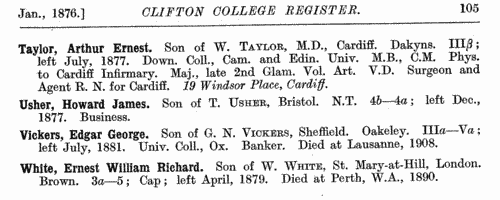
|  British riflemen fighting in Egypt
(1882) British riflemen fighting in Egypt
(1882)
The war medal roll for the Egyptian campaign of 1882 is annotated to show those men actually present at Tel-el-Kebir, and thereby also entitled to the Tel-el-Kebir clasp. In addition, there follows an almost duplicate roll of men entitled to the Bronze Star granted by the Khedive of Egypt in recognition of the campaign. The King's Royal Rifle Corps fought in the Egyptian war of 1882, including the battle of Tel-el-Kebir, and in the Soudan campaign of 1884: but this medal roll, compiled at Cairo in November 1882, relates only to the 1882 campaign. | Sample scan, click to enlarge

| Boys entering Cheltenham College
(1883)
Cheltenham College 'was founded in order to provide for the sons of gentlemen a Classical, Mathematical, and General Education of the highest order, on moderate terms, in strict conformity with the principles and doctrines of the Church of England.'
Andrew Alexander Hunter, the college registrar, compiled the first edition of the College Register in four parts from 1883 to 1886: these merely listed the boys by term of entry, with their dates of birth and names and addresses of their fathers. Circulars were also sent out to all Old Cheltonians whose addresses were known, requesting additional details. On the basis of the returns from these and Hunter's further researches, this much fuller register was published in 1890.
The information after each boy's name is given (where known and applicable) in this format: father's full name and address as of the time the boy entered the college; class and department on entering the college (classes being number from 1 downwards, and these again divided into A and B, some into C and D, others into P (Principal's side) and V. P. (Vice-Principal's side) - 1A was the highest class in each department: besides this, certain others were called Addiscombe, Woolwich, Civil, Direct, Line, Sandhurst, Naval, Special, Preparatory, Latin, and India Civil) and the same on leaving, name of Boarding House (or 'Day Boy'), scholastic and athletic honours attained at the college, and subsequent career (including date and place of death, or present address in 1890, if known).
Of course, in the case of these boys entering the school in the last few years before 1890 their career lay in the future, and the information gives relates only to their parentage and their time at school. | Sample scan, click to enlarge
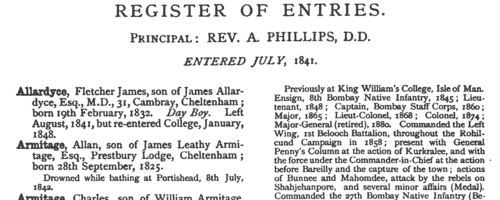
| Law students at Cambridge University
(1883)
Tripos lists or examination results for the year, arranged by class (First, Second and Third), and within each class in order of score in the examination (the names of students with equal marks being bracketed together). Each student's surname and college is given: this list was printed in 1890, and was annotated with asterisks to show which students had subsequently become fellows of the university; and with footnotes showing those who became judges, &c. These lists are particularly useful in identifying for an individual the fellow-students who will have attended lectures with him; and, where from the college, are likely to have been even more closely associated by having been under the same supervisor. (The sample scan is from the start of the Mathematics Tripos list for 1770) | Sample scan, click to enlarge

| Creditors under 22 & 23 Vict. c. 35
(1883-1884)
Volume 76 of The Law Times, 'The Journal of The Law and The Lawyers', a weekly publication, runs from 3 November 1883 to 26 April 1884. Much of the journal is taken up with law reports, leading articles, &c., and the 'Solicitors' Department' contains several regular features of great interest, including 'Creditors under 22 & 23 Vict. c. 35'. That was a piece of legislation introduced to protect executors and administrators from litigation (whether from kin or from creditors) after the assets of the deceased had been distributed, by allowing the publication of notices stipulating a Last Day of Claim, absolving the estate from later demands. These lists are therefore effectively those of the recently deceased whose affairs were in the process of being wound up; the index covers both the deceased and their solicitors. | Sample scan, click to enlarge

| Liquidations by Arrangement
(1883-1884)
Volume 76 of The Law Times, 'The Journal of The Law and The Lawyers', a weekly publication, runs from 3 November 1883 to 26 April 1884. Much of the journal is taken up with law reports, leading articles, &c., and the 'Solicitors' Department' contains several regular features of great interest. Lists of bankrupts, liquidations by arrangement, dividends and orders of discharge extracted from the London Gazette were published each week, and these have been indexed both for the principals and their solicitors. | Sample scan, click to enlarge

| Queen's Bench Appeals
(1883-1884)
Volume 76 of The Law Times, 'The Journal of The Law and The Lawyers', a weekly publication, runs from 3 November 1883 to 26 April 1884. Much of the journal is taken up with law reports, leading articles, &c., and the 'Solicitors' Department' contains several regular features of great interest. The court lists enable us to follow the progress of cases scheduled to be heard in the high courts. Many of these cases never actually came to be heard, litigation ceasing whilst in preparation, or being resolved 'at the door of the court'. In almost all cases the parties are referred to by surname only. The Court of Appeal heard appeals from the Chancery Division, the Probate, Divorce and Admiralty Division (Probate and Divorce), and the County Palatine and Stannaries Courts; from the Queen's Bench and Probate, Divorce, and Admiralty (Admiralty) Divisions; from the Probate, Divorce and Admiralty Division (Admiralty cases); and from the London Bankruptcy Court.
| Sample scan, click to enlarge

| Men-at-the-Bar
(1885)
Joseph Foster's Hand-List of Men-at-the-Bar gives a paragraph biography of men who had been called to the bar and were alive in 1885. After the full name (surname first, in capitals) there is a short statement of occupation or practice; a student at which inn of court; when called to the bar; father's name and then address; when born; if married, and, if so, wife's name (and her father's name) is often given. At the foot, in small type, is present residence, as of 1885. | Sample scan, click to enlarge
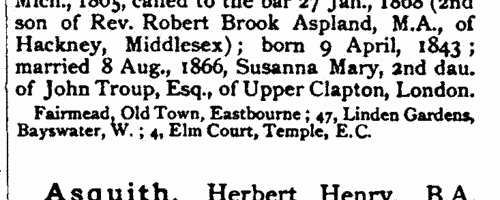
| Boys entering Harrow School
(1886)
This Second Volume of the Second Series of the Harrow School Register was edited by J. H. Stogdon and published in 1925. The boys are listed by term of entrance, and then alphabetically by surname and christian names (in bold). Next, in brackets and in italics, is the school house to which he belonged - or, H. B. indicating a day boy whose family lived in Harrow. Stogdon then gives the father's surname and initials, and address. In cases where the boy was prominent in sports at school, or won academic prizes, scholarships &c., that is given; then the year of leaving the school; a synopsis of his career; and, where known, his address as of 1925, in italics. | Sample scan, click to enlarge
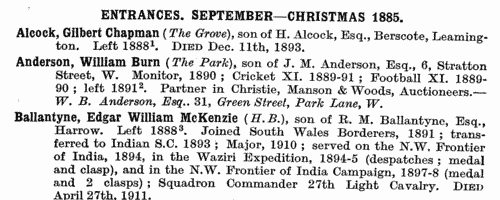
| Boys entering Uppingham School
(1886)
The public school at Uppingham in Rutland was founded by Archdeacon Johnson in 1584. A roll of scholars from 1824 to 1905 was edited by J. P. Graham, and published in 1906. This was a revision and updating of an 1894 edition of the roll, the great bulk of the work having been done by Mrs Mullins. The roll is arranged by year, and within each year by term of entrance, and then alphabetically by surname within each term. Each boy's name is given, surname first, with an asterisk where known (in 1906) to have died. Then there is month and year of birth, father's name (most often just surname and initials) and address (at entrance). Where the boy represented the school at Rugby football (XV) or cricket (XI), that is indicated. After the month and year of leaving the school, there is a brief summary of achievements in later life, and, where known, address as in 1906. From 1875 onwards the house within the school is also noted, with these abbreviations: A., Mr Constable's House; B., Brooklands; C., West Bank; E., Mr J. Gale Thring's House; F., Fircroft; Fgh., Farleigh; H., Highfield; L., The Lodge; L. H., Lorne House; M., Meadhurst; N., The Hall; R., Redgate; R. H., Red House; S., School House; and W. D., West Deyne. | Sample scan, click to enlarge
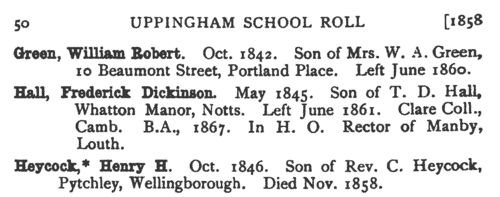
|
Research your ancestry, family history, genealogy and one-name study by direct access to original records and archives indexed by surname.
|












